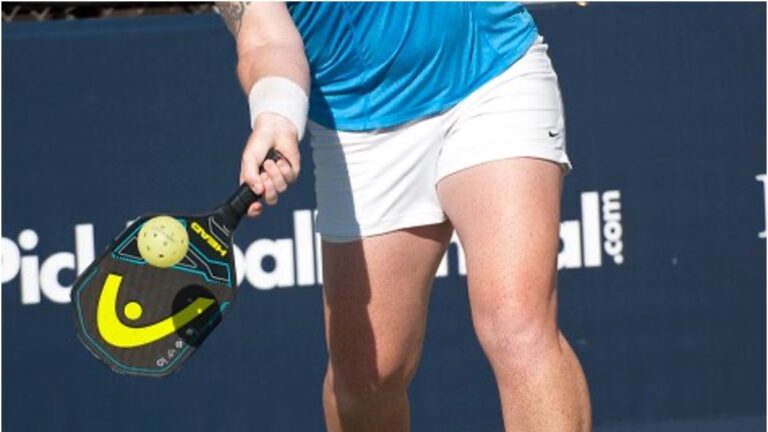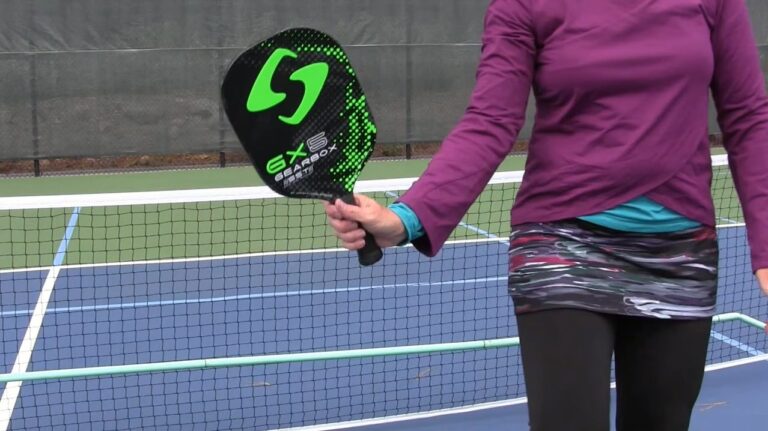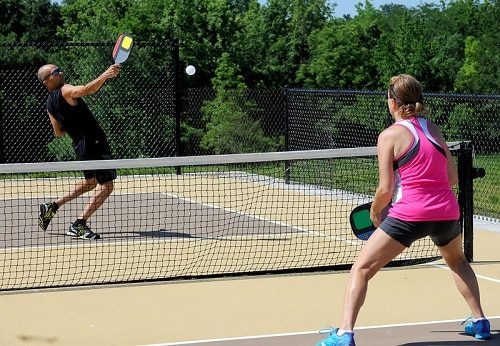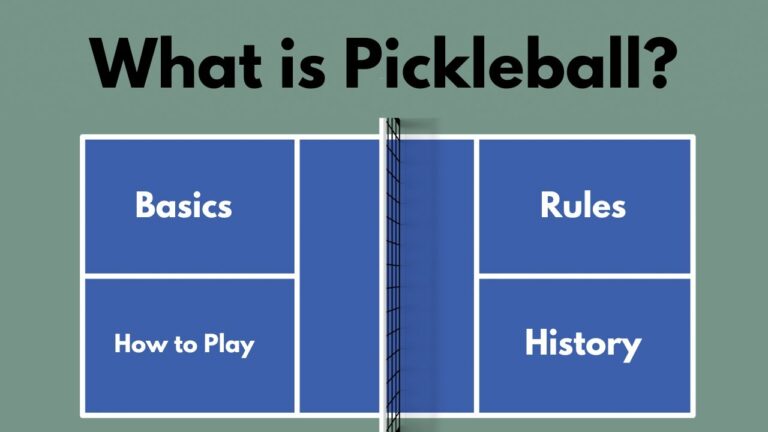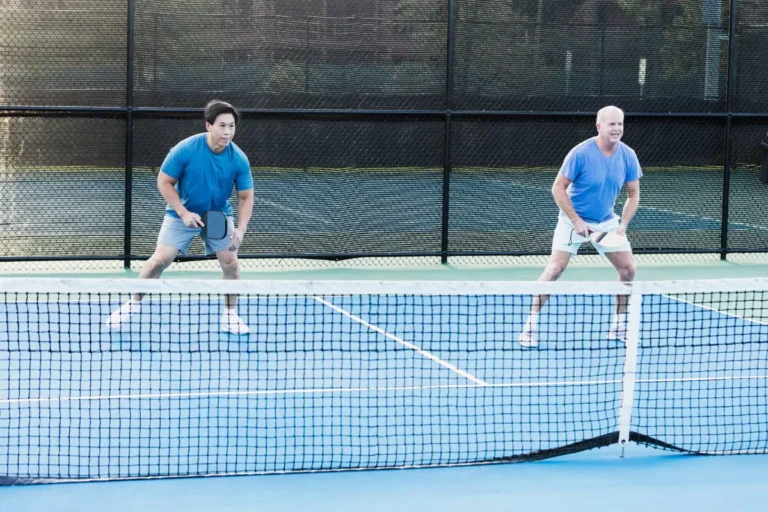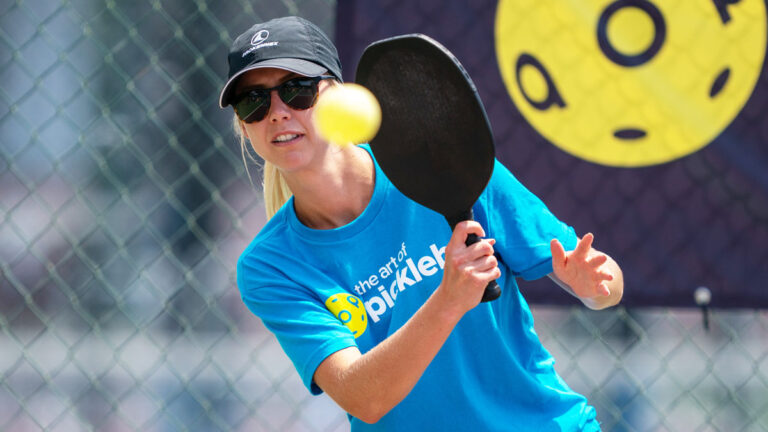Mastering the Game: Essential Pickleball Rules Explained
Pickleball Rules Explained
Pickleball’s played on a badminton-like court, with underhand serving below the waist being key. Your serve should clear the non-volley zone, aim for the opposite diagonal court, and avoid faults such as net hits. Only the serving team can score, and typically games are up to 11 points, won by a 2-point lead. Beware stepping into the non-volley zone and violating the double bounce rule. In doubles, court position hinges on the score. There’s plenty to master, and brushing up on pickleball strategies is sure to give your game a major lift.
Main Points
- Pickleball is played on a badminton-like court, with specific rules for serves, volleys, and groundstrokes.
- Only the serving team can score points, aiming for 11 with a ‘win by 2’ rule.
- Common faults include stepping into the non-volley zone, net hits, and not serving underhand and below the waist.
- In the non-volley zone, also known as the kitchen, volleys are not allowed and stepping on the line results in a fault.
- In doubles play, court position is determined by the team’s score with players serving from right court for even scores and left for odd scores.
Understanding Pickleball Gameplay
Diving into the gameplay pickleball, you’ll find it’s played on a 20 feet wide and 44 feet long court, similar to a badminton court, with a net that stands 36 inches high at the sidelines and 34 inches in the center, setting up a consistent playing area.
Your skill with groundstrokes, volleys, and serves will be put to the test. Groundstrokes are shots that you’ll execute after the ball has bounced once. They’re key to maintaining a good defensive position. Volleys, on the other hand, are executed without letting the ball bounce. They’re perfect for aggressive play, allowing you to catch your opponent off guard.
But be careful! There’s a non-volley zone, affectionately called the ‘kitchen‘. It’s a seven-foot zone on either side the net. You can’t volley within this zone; doing so will result in a fault.
Every rally begins with a serve. Your serve must be underhand, and it has to clear the kitchen. This can be tricky, but mastering your serve is critical to controlling the gameplay. With these rules in mind, you’re ready to start your pickleball journey.
Serving Rules in Pickleball
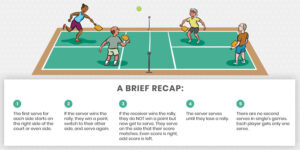
When it comes to the serving rules in pickleball, it’s important to know the right techniques.
You can’t overlook the possibility of faults occurring during your serve, which can impact your game greatly.
Proper Serving Techniques
In pickleball, you’ve got to serve underhand and below the waist to kick start a good rally. Proper serving techniques are important to initiate fair play and keep the game competitive. Remember, you only get one attempt to serve, so make it count.
Here are three key elements to think about:
- Underhand Serve: The serve has to be underhand and below your waist. It’s about technique, not power.
- Clear the Non-Volley Zone: Also known as the ‘kitchen’, your serve must clear this area to be valid.
- Diagonal Serve: Aim for the opposite diagonal court. It’s not just about serving but also directing the ball properly.
These rules ensure a balanced, competitive rally and uphold the spirit of pickleball.
Faults in Serving
As you master the art in serving in pickleball, it’s important to grasp the concept regarding serving faults and how to avoid them. Faults can occur with out of bounds serves, net hits, or when the ball isn’t allowed to bounce before hitting.
Here’s a quick reference table for you:
| Fault | Cause | Solution |
|---|---|---|
| Out of Bounds | Serve lands outside the court | Aim better |
| Net | Ball hits the net | Practice serving |
| Non-volley zone | Serve lands in the kitchen | Serve diagonally |
Also, remember that the serve must be underhand, made below the waist, and directed diagonally to the opponent’s court. Staying aware of these faults and adhering to the serving rules guarantees fair play.
Scoring With Serves
Now that you’re familiar with serving faults, let’s understand how scoring works in pickleball, particularly with serves.
- Scoring Points: Remember, only the serving team can score points in pickleball. They continue to serve, switching sides after each point, until a fault is made.
- Court Position: Your score determines your court position. In singles play, if your score is even, serve from the right court. If it’s odd, serve from the left.
- Win by 2 Rule: Games are usually played until a team reaches 11 points. However, the ‘win by 2’ rule applies, meaning you must win by at least a 2-point margin.
Mastering these serving strategies will put you in a strong position to win your pickleball games.
Common Pickleball Faults
While playing pickleball, you might encounter several common faults, such as stepping into the non-volley zone during a volley. This is considered a violation the game’s rules and can cause you to lose a point.
Another fault you may encounter is hitting the net during your serve or return. This will also result in a lost point. Just like in tennis, you must clear the net for the play to continue. It’s also a fault if your serve lands out bounds. In pickleball, precision is key.
The double bounce rule is another important aspect pickleball. If you volley the ball before it has bounced once on each side the net, you’ve committed a fault. Remember, patience is a virtue in this game.
Lastly, the underhand serve is a unique aspect pickleball. It’s a fault if you fail to serve underhand and below your waist. This rule helps level the playing field, making pickleball a game strategy rather than power.
Understanding these common faults can help improve your game and ensure fair play. Keep these in mind the next time you step onto the court. Be aware, play fair, and enjoy the game!
Navigating the Non-Volley Zone
Moving from common faults, let’s explore the intricacies within the non-volley zone, often referred to as the ‘kitchen,’ a 7-foot area on either side of the net where volleying is strictly off-limits. This rule isn’t just about control, it’s a detailed strategy that promotes fair play, deters aggressive net play, and fosters skill development.
Here’s a breakdown of what you need to know:
- Volleying Restrictions: You can’t hit volleys while standing in the kitchen. This prevents you from dominating the game with aggressive net play and ensures a level playing field.
- Faults: Stepping on the non-volley zone line during a volley will cost you a fault. This adds a degree of precision to the game, as you must balance your aggression with careful footwork.
- Strategy and Skill Development: The kitchen rule pushes you to use groundstrokes effectively and position yourself strategically. It adds an element of control and nuance to the game that rewards skill over brute force.
Rules for Pickleball Singles
Wondered how the game changes when you’re playing singles pickleball? You’re on your own, covering the entire court alone. The rules are still the same, but with some key differences. Let’s explore the specifics.
In singles pickleball, serving is important. You’ll start serving from the right/even court. As the game progresses, if your score is even, you’ll serve from the right court, and if it’s odd, from the left. The game is typically played to 11 points, and don’t forget the win by 2 rule.
The two-bounce rule still applies. Both you and your opponent must let the ball bounce once before hitting it back. This adds an extra layer of strategy to the game.
Here’s a quick summary:
| Rule | Description |
|---|---|
| Serving | Starts from the right/even court, alternates based on score |
| Scoring | Play to 11 points, must win by 2 |
| Two-bounce rule | Both players must let the ball bounce once before volleying |
Doubles Play in Pickleball
In doubles play, you and your partner need to master specific rules and strategies to win. Understanding serving rules, scoring systems, and court positioning is essential.
Let’s explore these points to enhance your team’s performance on the pickleball court.
Serving Rules in Doubles
When it comes to doubles play in pickleball, both players on the serving team get a chance to serve until they commit a fault. This means that you and your partner, as the serving team, can keep the advantage as long as you avoid faults.
Here’s a quick rundown on the process:
- Your serve must originate from the right court if it’s the first serve from a side-out.
- After scoring a point, you and your partner should switch sides.
- Your team’s score determines your court position for serving. If your score is even, serve from the right court; if it’s odd, serve from the left court.
Doubles Scoring System
Understanding the scoring system in doubles pickleball is essential to mastering the game, as only the serving team can score points. The score determines your court position, so keep track.
If you’re the serving team and your score is even, you’ll serve from the right court. If it’s odd, you’ll operate from the left court.
Games typically go to 11 points, but you have to win by 2. This rule keeps matches intense and competitive. Don’t forget about player rotation; it’s part doubles’ strategy.
Matches are usually best two out three games, ensuring a fair result. Remember, the scoring system in doubles pickleball isn’t just about points, it’s about court positioning and strategic rotation too.
Double’s Court Positioning
Just as mastering the scoring system is key to pickleball, so is knowing your court position during doubles play. In doubles play, you and your partner have designated positions, either on the right or left side of the court.
Your court positioning is essential for strategic placement and effective shots. Here’s a simple breakdown:
- You determine your court position based on your team’s score. If your team is serving, the player who serves first will be in the right/even court for even scores and the left/odd court for odd scores.
- Proper court positioning helps you and your partner cover the court efficiently.
- With good team coordination, you can outmaneuver opponents with your shot selection from your designated positions.
Decoding Pickleball Scoring
Diving into the distinctive domain within pickleball scoring, it’s important to know that only the serving team can rack up points during a game. This rule is a fundamental part of pickleball, distinguishing it from other racquet sports. Points lead to victory, and in a standard game, you’re aiming for 11 points. However, the catch is that you need to win by 2 points. This requirement adds a twist to the gameplay strategy, making the game more competitive and exciting.
In tournament matches, the stakes are higher. Games may extend to 15 or even 21 points, but the ‘win by 2’ rule still applies. This setup intensifies the competition and pushes you to refine your skills further.
Your court position is determined by the serving team’s score, hence understanding the scoring system is essential. It directly affects your gameplay strategy and your ability to effectively adapt during the game. Mastering pickleball scoring aids in progress tracking, giving you an edge in your pursuit of victory. So, embrace the challenge and let each point lead you to success in the exciting world of pickleball.
Locating Your Closest Pickleball Courts
Whether you’re a seasoned player or a beginner, finding your nearest pickleball courts is easier than you might think. These courts are often found in various locations such as parks, recreation centers, and dedicated facilities. Depending on the area, the availability of these courts might vary, so always check for the most current schedules.
Here are three easy steps to locate your closest pickleball courts:
- Use Online Resources: Websites like Places2Play and USAPA.org offer thorough databases listing pickleball court locations. You can simply input your area and find a list of nearby courts.
- Check Local Recreation Centers and Parks: Many parks and recreation centers have dedicated pickleball courts. Some even offer indoor courts, providing year-round playing opportunities.
- Join Local Clubs: Many communities have pickleball clubs that provide information on local playing opportunities.
Frequently Asked Questions
What Are the Basic Pickleball Rules?
You’re asking about the basics, right? Well, pickleball’s played on a 20×44 foot court. Only the server can score. There’s a 7-foot “no volley” zone. Games typically go to 11 points, but you’ve gotta win by 2.
What Is the Golden Rule Pickleball?
You’re asking about the Golden Rule in pickleball. It’s not about gameplay, it’s about respect and fairness. It’s about good sportsmanship, honesty, and integrity. It makes the game enjoyable and fosters community among players.
Can You Ever Step in the Kitchen in Pickleball?
Sure, you can step in the kitchen in pickleball, but only when you’re not volleying. If you volley from the kitchen, it’s a fault, handing the point to your opponent. So, be careful with your footwork!
How Do You Play Pickleball Step by Step?
You start by serving underhand diagonally. Rally the ball, scoring when the opponent faults. Stay clear from the kitchen unless the ball bounces there first. The first to 11 points, leading by 2, wins.
Conclusion
And there you have it! You’re now versed in the rules of pickleball. From serving to scoring, you’re ready to hit the courts.
Remember, practice makes perfect, especially when maneuvering the non-volley zone or playing doubles.
Whether you decide to play singles or doubles, the most important thing is to have fun.
So, grab your paddle, locate the nearest pickleball court, and enjoy this fantastic game.
Don’t forget, it’s all about the fun!

